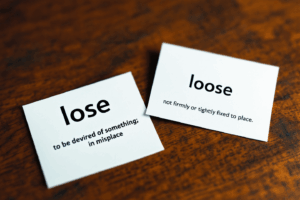
The Impact of Exercise on Mental Health: A Deep Dive
Mental and Emotional Health “Let’s Learn, Explore, and Connect to the World” The Impact of Exercise on Mental Health: A Deep Dive Introduction In the




Few word pairs cause as much confusion in the realm of English language nuances as “lose” and “loose.” While they may sound somewhat similar and are often mistaken for one another in writing, they carry entirely different meanings and uses. Understanding how to correctly use these words is crucial for clear and precise communication, as their misuse can lead to misunderstandings or perceptions of carelessness in casual and formal contexts.
“Lose” is a verb that means to be deprived of something or cease to have it, often used in contexts involving failure to win or misplacing items. On the other hand, “loose” is primarily an adjective used to describe something that is not tightly fitted or is free from constraint. Despite these clear distinctions, many continue to swap one for the other.
This article will clear up any confusion between lose and loose. We’ll explore what each word means, how to use them correctly, and give you some easy tricks to tell them apart. By the end of this guide, you should feel confident in choosing the correct word every time, enhancing both your written and spoken English skills. Let’s dive into the specifics and clear up doubts about when to use “lose” and “loose.”
Understanding the definitions and pronunciations of “lose” and “loose” is the first step to using them correctly. Here, we’ll explore each word in detail, providing a clear basis for differentiating them in everyday use.

Deprivation: She didn’t want to lose her special necklace.

Misplacing: I always lose my keys when I need them the most.

Failing to Win: They played well but still lost the game.
Pronunciation Tip: The word “lose” rhymes with “choose,” which can help remind you that it deals with choosing incorrectly or failing to keep something.

Adjective: The bolt was loose, so I tightened it with a wrench.

Verb (less common): Be careful with that handle; it might lose the cable.
Pronunciation Tip: “Loose” rhymes with “moose,” indicating something free or unbound, like a moose roaming freely in the wilderness.
Understanding these definitions and their etymological roots provides a solid foundation for remembering their distinct uses. Though subtle, the slight difference in pronunciation can also be a helpful cue in recalling which word to use when writing or speaking. By keeping these definitions and examples in mind, you can begin to internalize the differences and apply them more confidently in your everyday communication.
The verb “lose” is frequently used in the English language and covers a variety of meanings, primarily involving the loss of something, whether it’s losing a physical object, losing a competition, or experiencing loss in a broader, often abstract sense. Understanding how to use “lose” accurately is crucial for clear communication. Here’s a deeper look into its correct usage with examples:
One common usage of “lose” indicates the misplacement or unintended removal of a physical object.

“Lose” is often used in the context of competitions or contests to describe failure to emerge as the winner.

“Lose” can also refer to more abstract concepts, such as losing one’s patience, losing focus, or losing interest in something.

A frequent error involves confusing “lose” with “loose.” Remember, “lose” involves a form of deprivation or failing and is never used as an adjective.

Incorrect: “Make sure you don’t loose your grip on the rope.”
Correct: “Make sure you don’t lose your grip on the rope.”
Here are a few tips to ensure you use “lose” correctly:
By regularly practicing these distinctions and applying the tips above, you can solidify your understanding of “lose” and enhance your accuracy in both writing and conversation. This ensures that your messages are delivered clearly and understood as intended, avoiding common confusion that can detract from effective communication.
Telling “lose” and “loose” apart can be tough, but some fun memory tricks and pictures can help you remember which is which! Here are some effective strategies to help ensure you never confuse these two words again.
Using these mnemonic and visual strategies can significantly aid in remembering the distinct meanings and uses of “lose” and “loose.” The more you practice using these tricks, the easier it will become to pick the right word automatically. This will make your writing clearer and more exact. These tools simplify learning and make the process more engaging and memorable.
To truly master the use of “lose” versus “loose,” consistent practice is key. Engaging in exercises that challenge you to apply these words correctly can solidify your understanding and help you internalize their proper usage. Here are some practical ways to practice and reinforce what you’ve learned:
 Fill-in-the-Blank Exercises: Create or find exercises where you must choose between “lose” and “loose” to complete sentences. This exercise forces you to think about the context and meaning of each sentence, enhancing your ability to differentiate between the two words.
Fill-in-the-Blank Exercises: Create or find exercises where you must choose between “lose” and “loose” to complete sentences. This exercise forces you to think about the context and meaning of each sentence, enhancing your ability to differentiate between the two words.
 Daily Writing Prompts: Incorporate daily or weekly writing prompts into your routine that focus on scenarios involving loss or scenarios requiring the description of items that are not tightly secured. Using “lose” and “loose” in your narratives or journal entries will help reinforce their meanings and proper use.
Daily Writing Prompts: Incorporate daily or weekly writing prompts into your routine that focus on scenarios involving loss or scenarios requiring the description of items that are not tightly secured. Using “lose” and “loose” in your narratives or journal entries will help reinforce their meanings and proper use.
 Peer Review: Exchange writing pieces with a friend or colleague and review each other’s work specifically looking for the use of “lose” and “loose.” Peer feedback can provide new insights and corrections you might not notice alone.
Peer Review: Exchange writing pieces with a friend or colleague and review each other’s work specifically looking for the use of “lose” and “loose.” Peer feedback can provide new insights and corrections you might not notice alone.
4.  Flashcards: Create flashcards with “lose” on one side and its definition and usage examples on the other, and do the same for “loose.” Regularly testing yourself with these cards can help cement the differences in your memory.
Flashcards: Create flashcards with “lose” on one side and its definition and usage examples on the other, and do the same for “loose.” Regularly testing yourself with these cards can help cement the differences in your memory.
 5. Engage in Online Forums or Social Media Discussions: Participate in language learning forums, social media groups, or comment sections where people discuss common English mistakes. Engaging in these discussions and explaining the difference to others can further deepen your understanding.
5. Engage in Online Forums or Social Media Discussions: Participate in language learning forums, social media groups, or comment sections where people discuss common English mistakes. Engaging in these discussions and explaining the difference to others can further deepen your understanding.
 6. Mobile Apps and Games: Numerous language learning apps offer word usage exercises. Engaging with these apps can provide a fun and interactive way to practice using “lose” and “loose” correctly.
6. Mobile Apps and Games: Numerous language learning apps offer word usage exercises. Engaging with these apps can provide a fun and interactive way to practice using “lose” and “loose” correctly.
By actively incorporating these practice methods into your learning routine, you become more adept at distinguishing “lose” from “loose” and improving your overall language skills. Regular practice in real-life contexts, writing exercises, and interactive learning will ensure you remember the correct usage naturally and confidently.
Mastering the usage of “lose” and “loose” extends beyond simply memorizing definitions—it involves understanding the context and nuanced differences that dictate their use. This deeper level of comprehension ensures you can easily navigate even the trickiest language situations. Here are some advanced tips to help you refine your understanding and application of these commonly confused words:
By cultivating a deeper awareness of the contexts and nuances associated with “lose” and “loose,” you can enhance your linguistic precision and confidence. This nuanced understanding not only aids in correct word usage but also enriches your overall engagement with the English language, allowing for more articulate and effective communication.
 Mastering the difference between “lose” and “loose” is more than just a detail of grammar—it’s a step towards clearer and more effective communication. By understanding the distinct meanings, practicing their correct usage, and remembering the tips and mnemonic devices shared, you can avoid common errors that often lead to confusion. As you continue to engage with English, whether in writing or speech, keep in mind these distinctions and apply them conscientiously. Remember, every effort you make to refine your language skills contributes to more precise and confident expression, enhancing personal and professional communication.
Mastering the difference between “lose” and “loose” is more than just a detail of grammar—it’s a step towards clearer and more effective communication. By understanding the distinct meanings, practicing their correct usage, and remembering the tips and mnemonic devices shared, you can avoid common errors that often lead to confusion. As you continue to engage with English, whether in writing or speech, keep in mind these distinctions and apply them conscientiously. Remember, every effort you make to refine your language skills contributes to more precise and confident expression, enhancing personal and professional communication.

Mental and Emotional Health “Let’s Learn, Explore, and Connect to the World” The Impact of Exercise on Mental Health: A Deep Dive Introduction In the

Digital Marketing Blogs “Let’s Learn, Explore, and Connect to the World” Instagram Insights and Analytics: Understanding Your Audience and Measuring Introduction However, navigating this

Laugh and learn with ‘Comic Collections’ by Cassia North – a delightful dive into everyday conversations in professional and casual settings, now in a vibrant, humor-filled ebook. Perfect for all ages!



